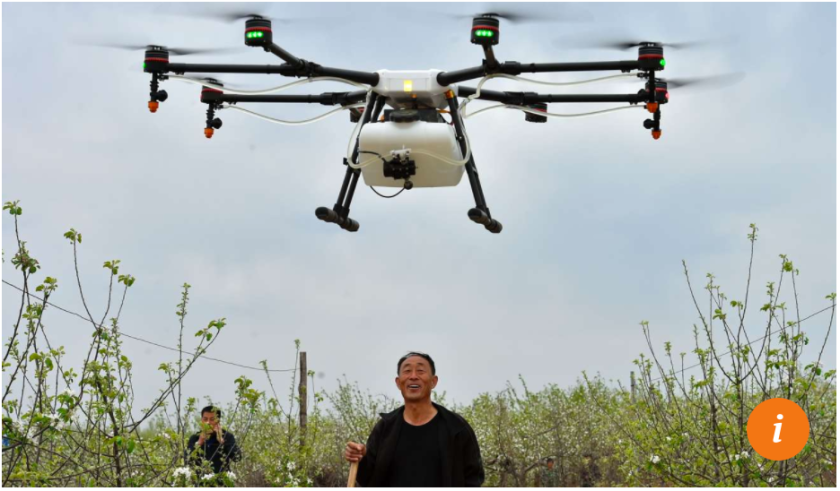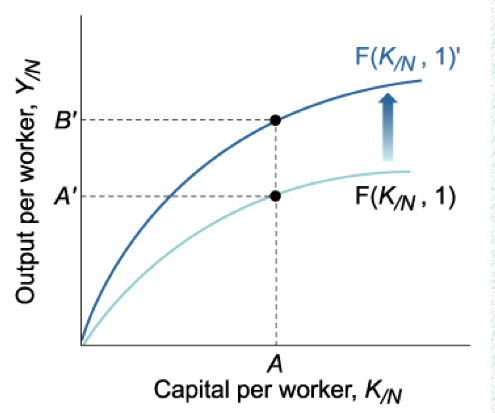By Yiwen Sun

Reported by South China Morning Post, earlier in 2017, farmers in Ji County, Shanxi Province in China hired drones to spray pesticides over apple orchards. These drones were equipped with tanks of pesticides attached to the belly, then flew over paths calculated and controlled by operators on site remotely. They achieved an efficiency of spraying one orchard in 10 minute, which was 15 times more efficient than manual labor, while the cost was 1,000 Yuan ($145) lower than hiring farm labor per hectare (2.47 acres) of orchard. (Chen, 2017)
Due to China’s fast-growing economies, big cities such as Shanghai and Shenzhen attract young labor from rural areas of China, creating a large labor shortage in the farming industry. The basic structure in the rural areas of China remains family owned and operated small farms with small plots of land, and farmers in neighboring areas tend to plant similar products due to the similar land and weather conditions. For example, Shanxi Province mentioned in this new article is famous for its apple production. By doing this, the local farming industry can be better organized on a county or village level, and it is more efficient for farmers to adapt to new technologies. Liu Xinzhu, a 60-year-old farmer in Ji County, Shanxi Province told Xinhua News with his son working in the big city, he could not take care of his one hectare of apple orchard by himself. (Chen, 2017) The cost of hire labor on farmland was high due to labor shortage in rural areas as well.
Production Model and Technology Adoption
The classical production function model is a function of output given labor and capital. In the short run, farmers do not purchase equipment just for a short-term use, and capital is relatively fixed. Through contacting and hiring drone operators or receiving trainings, farmers may face a small up-front cost of utilizing drones, while the ongoing costs will only be the rental fees during pest control each season. As mentioned previously, with the same amount of labor, drones are 15 times more efficient than labor. This huge increase in output can be reflected by A’ to B’ in the graph below. Aside from high productivity, agricultural drones also save 30 to 40 percent of pesticides, which is efficient for the family owned and operated small plots of land in the rural areas of China (Jiang, 2016).

*Output=F (K, AL) shows an increase in productivity of labor with technology. Picture retrieved from https://snbchf.com/economic-theory/the-long-run/
In the case described in the news article, there is a very high opportunity cost of working on the family farm instead of looking for outside job, such as for Liu’s son. According to China Labor Bulletin, the minimum wage in major cities and province capitals was about 1,600 Yuan ($239) per month in 2016, and it has been rising continuously over the years. Aside from the technology augmented production model, we see an obvious substitute effect between labor and capital in the long run. Without pesticide spraying drones, farmers invest money to purchase other pest control equipment. One of the cheapest type is a plastic tank farmers carry on their back, and farmers press on a lever to spray as they walk, but it is not efficient. It only lasts for a few years, and farmers inhale toxic chemicals along the way. Advanced pest control equipment such as the overhead spray can sometimes cost as much as hundreds of dollars, which farmers in rural areas cannot afford. Instead of investing in capital in the long run, farmers in China now hire drone operation companies for pest control seasonally. Providing only the pesticides, farmers make no investment in capital and no long need to come up with a large sum of money. In this case, farmers can spend money in hiring more units of labor, which are the drone operators, with higher productivity and at lower cost. Overall, farmers shift their spending from capital to labor, and achieve a higher productivity with low health risks, which are a much more efficient allocation of resources.
Future Projections
Described in the news article, government experts in China estimated agricultural drones have a potential to generate 100 billion yuan per year in China. In Shenzhen, there are currently about 200 professional drone operators who offer services to farmers across China. (Chen, 2017) DJI, a drone manufacture company based in Shenzhen, China, is finding a huge potential in agricultural drones. In 2016, the company’s plan was to train ten million people in China to operate drones, and establish a chain of after-sales service. (Schroth, 2016) However, the utilization of drones in general still lacks sophisticated regulations in China. Although some drone regulations were released in 2016, many operations still need to go through tests and paperwork.
References
Chen, S. (2017, April 27). China’s pesticide drones ‘a godsend’ amid rural exodus. Retrieved May 02, 2017, from http://www.scmp.com/news/china/society/article/2091150/drones-godsend-chinas-struggling-orchardists
Jiang, S. (2016, July 25). Drones for agricultural use taking off in China. Retrieved May 02, 2017, from http://www.scmp.com/business/companies/article/1994543/drones-agricultural-use-taking-china
Schroth, F., & Says, T. L. (2016, March 24). DJI Establishing Agricultural Drone Service Network in China. Retrieved May 02, 2017, from http://dronelife.com/2016/03/22/dji-expanding-agricultural-drones-in-china/
Wages and employment. (2016, July 20). Retrieved May 02, 2017, from http://www.clb.org.hk/content/wages-and-employment
It’s interesting to see a rental market for agricultural equipment. As we discussed in class, that is uncommon, because of correlated demand. What aspects of the drones do you think facilitate rental markets that work better than markets for tractors, for example? Is timing of pesticide application more flexible? Does the need to hire an operator help or hurt the functioning of rental markets?
LikeLike
I find it amazing how this new invention, which was designed for camera use, can now be utilized in so many ways. With the potential growth of the drone market rising in China, would this new technology ultimately be hurting the economy by lowering the available job opportunity? Though the job opportunity for drone operators would be increasing, wouldn’t it be considered a skilled job which could hinder the unskilled labor market?
LikeLike
I find this topic extremely interesting and relevant to our ever-changing technological environment. Realizing that drones could be used to spray pesticides over a large area of crops seems like a no-brainer since it is much easier than flying a plane over it and much cheaper than hiring farm hands to walk through the crops and spray plants individually. The production model that you provided allows me to clearly see the benefits from this. Do you think that this could be made into a huge market around the world, not just China? Is the fact that it takes place in a tech giant like China mean that it can’t be repeated in other less techy rural countries?
LikeLike
I found this blog to be an interesting example of how technology can augment a labor market. The introduction of drones has helped these farmers increase their productivity and, as a result, their output. Other methods of crop preservation do not produce as much output as drones. For example, human laborers are less efficient than drones; it takes them much longer to cover a plot of land with pesticides. On the other hand, other pest control equipment reduces output compared to drones because they have high costs. I’m curious how the advent of drones in agriculture will affect labor supply. It is possible that the introduction of drones will hasten the trend of rural people migrating to urban areas to work.
LikeLike